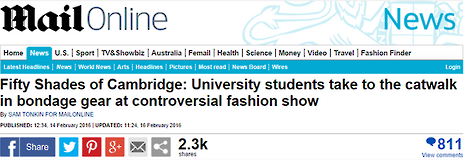Dear Daily Mail
Laura Day responds to the Daily Mail’s coverage of the Cambridge University Charity Fashion Show

On Saturday evening, I attended the Cambridge University Charity Fashion Show (CUCFS). I stood by the catwalk, and watched my fellow students parade up and down in a myriad of designs, each as eclectic and unorthodox as the last. While there was occasionally a more orthodox piece, most of the fashion on show was a little more unconventional, and certainly a little more provocative.
Nevertheless, it was a fantastic display, and the evening was a resounding success. The Corn Exchange was transformed into something out of London Fashion Week, and the guests were dressed as well as the models, albeit adhering to more stringent black tie rules. Free drinks were on tap, and Nanna Mexico was on call to feed the hungry show-goers. The music featured renowned artist Jungle, and the entire night was in the name of a charity: Cambridge House. The team of student organisers behind the scenes pulled off an amazing array of entertainment and organisational feats, and should be highly commended for the immense effort that was surely put in to such a successful evening.
Yet, as one might expect, certain facets of the wider British media couldn’t manage to get their lack of journalistic prowess past the near nudity of some of Cambridge’s student models.
In their rapidly-published (read: rushed) article the following afternoon, the Daily Mail opened with a headline reading ‘Fifty Shades of Cambridge’, and proceeded to deem the designs worn by the students ‘bondage gear’, and that the entire fashion show was ‘controversial’.
So, to the poor, unenlightened and, quite frankly, meagre reporters from the Daily Mail, I offer you an analysis of your very own words, broken down piece by piece, outlining just how wrong you are. Forgive me, if you please: I am an English Literature student, and this happens to be what we do best.
Firstly to your ‘bondage gear’ reference when describing the designs on show. How would you feel if you’d spent a great deal of time, effort, and investment in following your passion for designing clothing, only to have them disregarded as secondary to the matter of who happens to be wearing them at a show aimed at showcasing the clothing above all else? Spare a thought, would you, for the designer who worked tirelessly to not only craft the piece, but also who had to work with the CUCFS committee to ensure that their designs were shown in just the right way during the show. It’s not just about putting the clothes on a model.
Furthermore, in this day and age, with so many body-conscious young people constantly at war with themselves over how they look, or how they don’t look, and why they can’t emulate the figures of the world’s supermodels, what is the value in commenting on how a jumpsuit revealed one of the students’ ‘assets’? Some of us in the crowd may have been paying attention to the clothing design (you know, the elegant black mesh jumpsuit by designer Amanda Wakeley), so it is somewhat disturbing to think that your minds were elsewhere.
And please do enlighten me as to the reasoning for your labelling the fashion show as ‘controversial’. What exactly made it controversial? Was it the clothing that you have deemed to be as such? The fact that it was a bunch of unknown students parading about in an event that is not the norm at universities up and down the country? The reality that nobody else cares except journalists who want to stir up a bit of controversy of their own, about something they know very little about? Or the fact that the entire spectacle was a way of raising funds for a charity: Cambridge House?
Surely it can’t be the latter. It can’t be, simply because this was the sole drive behind the show. The committee’s tireless efforts since the beginning of Michaelmas Term culminated in £10,000 being raised for the charity, one that was begun by Cambridge alumni in 1889 to ease social injustice in South London. The show celebrated the diversity of not only the designers, but also of the students involved. Each model and each committee member had a different story, whether that be the degree they’re studying, the college they live in, their connection to the world of fashion, or to the Cambridge House charity.
Next year, when this phenomenal fundraising event takes place once again, I’d implore journalists across the country, whether they are representatives of student publications or of national ones, to take a minute to garner some perspective.
Why bother looking at something if the only desire is to create controversy? Instead, approach things with an ounce of respect and admiration. After all, were you ever responsible for raising so much money for charity?
When was the last time you gave up hours of freedom to liaise with designers, organise food and drink, decorate a venue, and coordinate the demands of many a live act? And have you ever been brave enough to strut your stuff down the catwalk in front of 1,000 spectators, some of whom you’ll undoubtedly be sat next to in lectures on Monday morning?
Nah, didn’t think so.
 Interviews / You don’t need to peak at Cambridge, says Robin Harding31 December 2025
Interviews / You don’t need to peak at Cambridge, says Robin Harding31 December 2025 Comment / What happened to men at Cambridge?31 December 2025
Comment / What happened to men at Cambridge?31 December 2025 News / Unions protest handling of redundancies at Epidemiology Unit30 December 2025
News / Unions protest handling of redundancies at Epidemiology Unit30 December 2025 News / Varsity’s biggest stories of 202531 December 2025
News / Varsity’s biggest stories of 202531 December 2025 News / Downing investigates ‘mysterious’ underground burial vault 29 December 2025
News / Downing investigates ‘mysterious’ underground burial vault 29 December 2025









